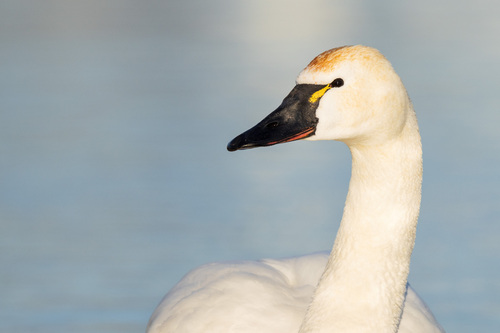
Tundra Swan
The Tundra Swan (*Cygnus columbianus*) is a large, elegant waterfowl species known for its striking white plumage and long, graceful neck. It plays a crucial role in its wetland ecosystems, primarily as a consumer of aquatic vegetation, influencing plant community structure. It's also a symbol of wilderness and seasonal change, undertaking impressive long-distance migrations. Culturally, the Tundra Swan has appeared in folklore and art, reflecting its beauty and the remote, pristine habitats it often occupies.
115-150 cm
Length
168-211 cm
Wingspan
Least Concern
Conservation Status
Distribution
The Tundra Swan breeds in the Arctic and subarctic regions of North America and Eurasia. Its North American breeding range extends from Alaska across northern Canada to Hudson Bay. It migrates south for the winter, reaching the Pacific coast from southern Alaska to California, the Atlantic coast from Maryland to South Carolina, and inland areas of the western United States.
Lifespan
The average lifespan in the wild is around 10-20 years, but some individuals can live much longer, with records of over 24 years.
Tundra Swan's Habitat
Habitat Types
Arctic tundra, Coastal marshes, Lakes, Rivers, Estuaries, Agricultural fields (during migration and winter)
Climate Zones
Arctic, Subarctic, Temperate
Adaptations
Tundra Swans possess dense, waterproof plumage and a thick layer of down for insulation in cold climates. Their large webbed feet are adapted for swimming and walking on soft substrates. They also have specialized salt glands to excrete excess salt when inhabiting coastal areas.
Variations
Two subspecies are generally recognized: *Cygnus columbianus columbianus* (Whistling Swan) in North America and *Cygnus columbianus bewickii* (Bewick's Swan) in Eurasia. Bewick's Swan is slightly smaller and has more extensive yellow markings on the bill.
Appearance
Breeding Plumage
Adult plumage is entirely white year-round.
Seasonal Feather Changes
There are no significant seasonal variations in plumage color. Juveniles have grayish plumage that gradually turns white during their first year.
Sex Based Plumage Differences
There is no noticeable sexual dimorphism in plumage color.
Notable Features
Long, elegant neck, All-white plumage (in adults), Black bill with a small yellow patch near the eye (extent varies by subspecies), Black legs and feet
Diet and Feeding
Primary Foods
Aquatic plants (leaves, stems, roots), Tubers, Seeds, Grains (especially during migration and winter), Small invertebrates (occasionally)
Foraging Behavior
Tundra Swans primarily feed by dabbling, submerging their head and neck to reach underwater vegetation. They also graze on land, particularly in agricultural fields. They often feed in family groups.
Specializations
Their long necks allow them to reach submerged vegetation in deeper water than many other waterfowl species. Their bills have serrated edges that help them grasp and tear plant material.
Seasonal Diet Variations
During the breeding season, they primarily consume aquatic plants. In winter and during migration, they may shift to a diet that includes more grains and agricultural crops, when available.
Behavior
Social Structure
Tundra Swans are highly social, particularly outside the breeding season. They often migrate and winter in large flocks. During the breeding season, they are territorial and defend their nesting area.
Communication
Loud, bugling calls (Whistling Swan), Softer, more musical calls (Bewick's Swan), Head bobbing, Wing quivering
Migration
Tundra Swans undertake long-distance migrations between their Arctic breeding grounds and their wintering areas. They follow established flyways and often stop at traditional staging areas to rest and refuel. Migration is triggered by changes in day length and weather conditions.
Territorial or Group Behaviors
During the breeding season, pairs are highly territorial and will aggressively defend their nesting territory from other swans and potential predators. Outside the breeding season, they are gregarious and form large flocks.
Conservation
Threats
Habitat loss and degradation (wetlands and agricultural lands), Lead poisoning (from ingestion of lead shot), Collisions with power lines, Climate change (affecting breeding habitat and food availability), Hunting (legal and illegal in some areas)
Protection Programs
Migratory Bird Treaty Act (in North America), Wetland conservation and restoration programs, Regulations on lead shot use, Monitoring of populations and migration routes
Local National Laws
Protected under various national and international laws, including the Migratory Bird Treaty Act in the United States and Canada.
Population Trend
Stable
Population Estimates
The North American population is estimated to be over 300,000 individuals. The Eurasian population (Bewick's Swan) is smaller and has experienced some declines.
Interesting Facts
Tundra Swans can fly at altitudes of over 8,000 feet.
They have been observed at these heights during migration, taking advantage of favorable winds.
They are known for their strong family bonds.
Cygnets often stay with their parents throughout their first winter and may even migrate with them.
The name "Whistling Swan" comes from the sound of their wings in flight.
The wingbeats produce a characteristic whistling sound, especially noticeable during takeoff and landing.
Bewick's Swan individuals can be identified by their unique bill patterns
The yellow markings on the bill vary in size and shape, allowing researchers to track individual birds.
Faqs about Tundra Swan
What is the difference between a Tundra Swan and a Trumpeter Swan?
Tundra Swans are smaller than Trumpeter Swans and have a small yellow patch near the eye on their black bill (although some Tundra Swans lack the yellow patch). Trumpeter Swans have an all-black bill that appears to merge with the eye, creating a different facial profile.
Do Tundra Swans mate for life?
Tundra Swans generally form long-term pair bonds that often last for life. However, if one member of the pair dies, the surviving swan may find a new mate.
How can I help protect Tundra Swans?
You can support wetland conservation efforts, avoid using lead shot for hunting, and advocate for policies that protect migratory birds and their habitats.
Where is the best place to see tundra swans?
During winter look for large gatherings of swans on open water bodies, such as lakes, estuaries, and flooded fields along their migration routes. Key areas include the Pacific and Atlantic coasts of North America. During breeding season, they inhabit remote Arctic regions.
Copyright @ Nature Style Limited. All Rights Reserved.
 English
English